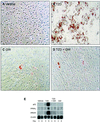A peroxisome proliferator-activated receptor gamma ligand inhibits adipocyte differentiation
- PMID: 10339548
- PMCID: PMC26842
- DOI: 10.1073/pnas.96.11.6102
A peroxisome proliferator-activated receptor gamma ligand inhibits adipocyte differentiation
Abstract
The peroxisome proliferator-activated receptors (PPARs) are nuclear hormone receptors that regulate glucose and lipid homeostasis. The PPARgamma subtype plays a central role in the regulation of adipogenesis and is the molecular target for the 2, 4-thiazolidinedione class of antidiabetic drugs. Structural studies have revealed that agonist ligands activate the PPARs through direct interactions with the C-terminal region of the ligand-binding domain, which includes the activation function 2 helix. GW0072 was identified as a high-affinity PPARgamma ligand that was a weak partial agonist of PPARgamma transactivation. X-ray crystallography revealed that GW0072 occupied the ligand-binding pocket by using different epitopes than the known PPAR agonists and did not interact with the activation function 2 helix. In cell culture, GW0072 was a potent antagonist of adipocyte differentiation. These results establish an approach to the design of PPAR ligands with modified biological activities.
Figures




References
MeSH terms
Substances
Associated data
- Actions
LinkOut - more resources
Full Text Sources
Other Literature Sources
Molecular Biology Databases

